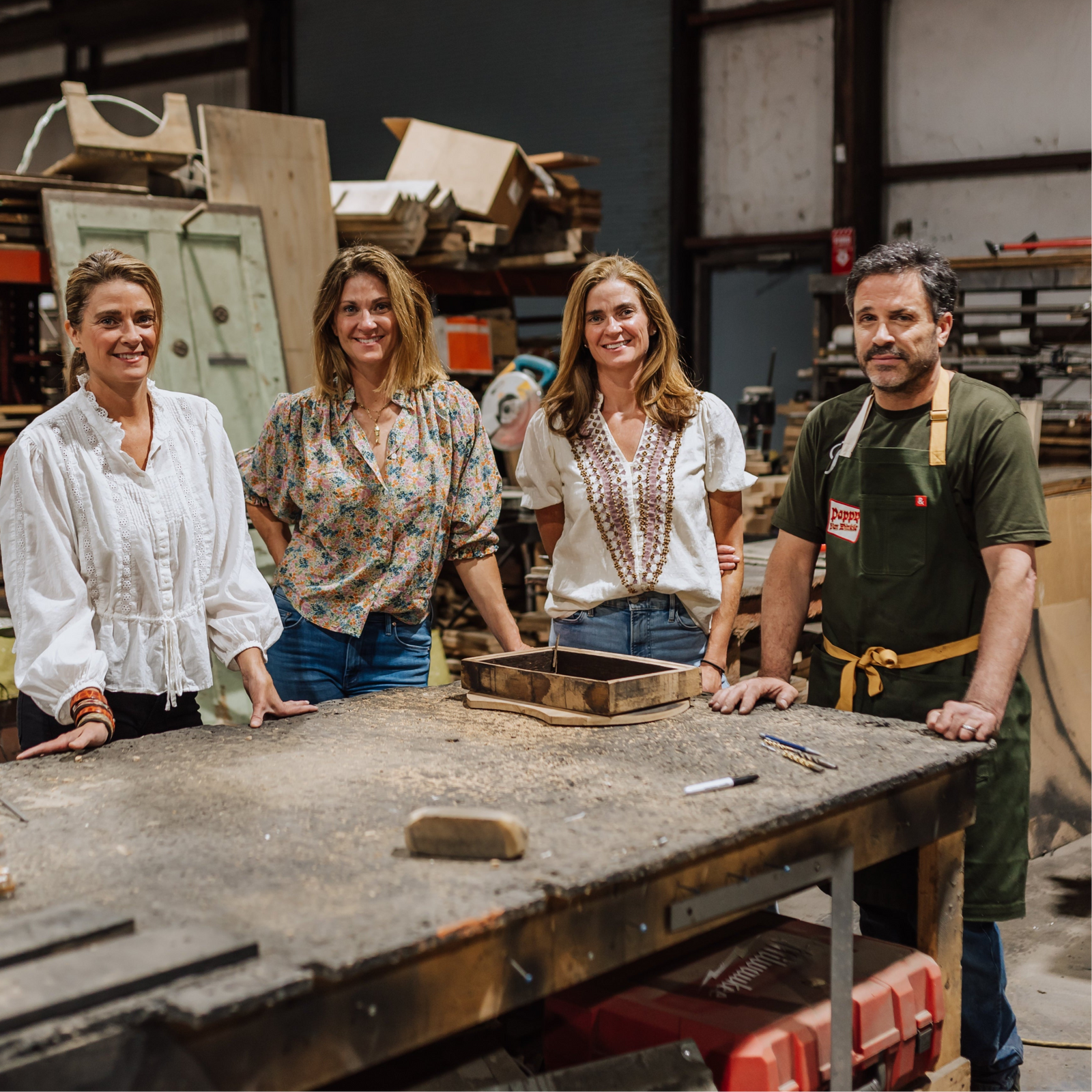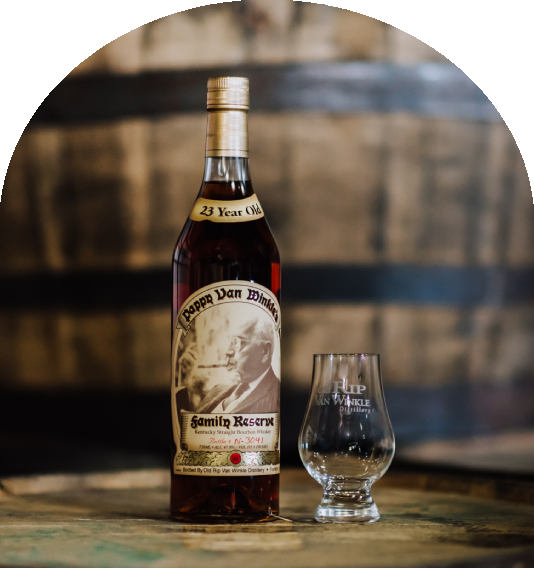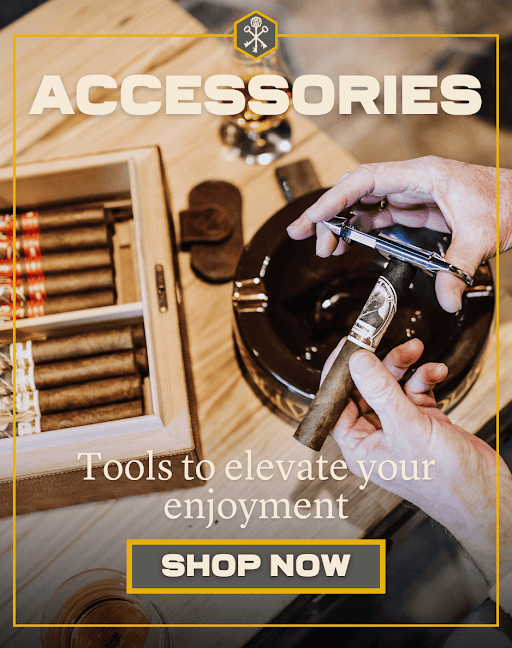Pappy Van Winkle Bourbon Barrel Heads, an iconic piece of bourbon history.
What makes a good whiskey? What makes a whiskey good? Growing up as a part of a bourbon family, we never really asked ourselves this question. It wasn’t until we started our own company and began to realize that what we had always just intuited to be such a natural and intertwined part of the legacy of not only our family, but of Kentucky itself, wasn’t understood by everyone.
The process is so full of nuance and specialization, attention to detail, dedication to craft, adherence to a process that honors each step along the way and never wavers from the overall promise to quality. So much of what goes into making the legendary bourbon is tied up in lore, some chalk it up to a mysterious good luck, others know it is hard work. Time, patience, high standards, sweat, and a good palette. Those are the real secrets to the so-called sauce.

If it begins with the barrel, then certainly we promise it doesn’t end there. The barrel, quite literally the home to the golden amber liquid as it ages, infusing itself with all of those mysterious elements that will transform it into the bottled product we all know and love, arguably has the most important job. Aging and protecting the bourbon for as many as 23 years is certainly not a small task, and one undertaken quite beautifully when you take the time to think about it.
So when you realize that the next step of the distilling process, the bourbon dump, all but renders the barrel a forgotten element, it seems initially shocking. Retired from the bourbon making process, a barrel, by nature of the foundation of what classifies a whiskey as bourbon, can't be used again for the purpose of aging it. So a new life awaits, and for us, we'd like that life that remain as linked to the legacy it helped to create as possible. We had a few motivations when we started Pappy & Company, amongst them being the desire to share our family’s legacy in meaningful ways that while extending beyond the bourbon always maintains the legacy throughout. Fortunately, we inherited from an early age as we watched how hard our dad worked, and heard the stories of his dad and grandfather before him. We innately understood that legacies aren’t in fact just born, but rather built, steadily, over time and we tasked ourselves with the question of how to go beyond the bottle, go beyond the barrel and bring that legacy, those characteristics and that promise to all of you.
So we began where the distilling process leaves off, with the barrel. With a desire to sustainably reuse these barrels, to not only give them a second life, but to allow them their rightful place in sharing in the legacy of the bourbon so recently housed within their walls. Exclusively available to Pappy & Company, the Pappy Van Winkle and Old Rip Van Winkle barrels are earmarked for a variety of purposes. Our collection of Pappy Van Winkle Barrel-aged food, Pappy Van Winkle barrel-fermented premium cigars, and our line of home goods and accessories crafted from barrels, was born.
From the staves, to the barrel heads to even the barrel hoops, we work with a variety of artisans and craftsmen to design, craft and create unique pieces that carry on the legacy of their iconic role in the bourbon process. After each barrel is dumped, we receive them and begin the painstaking process of breaking them down to preserve their dignity, uniqueness and their inimitable aroma and characteristics.

Each barrel weighs approximately 125 pounds once emptied and requires multiple people and an assembly line to properly and carefully disassemble them. They are carefully disassembled in a process that aims to preserve every element of the barrel for particular reuse. Thin or broken staves are cut down into smaller pieces and turned into our smoking chunks. Other staves are removed and collected by width to be turned into a variety of products, such as our smoked cocktail kits, cutting boards, and stave bowls. Working with our partners and like minded craftsman to find new ways to create unique products from our barrels is truly one of the most exciting elements of product development and thrilling elements of what we are able to do with our company.
(A certain number of barrels are held aside for our partners to use for aging our gourmet collection and cigars. Those that remain are disassembled for our barrel-made collection) stay tuned for more...
The barrel heads themselves often tell the story, much in the way when a tree is cut down you can decipher the life of the tree it supported. The longer the bourbon has aged, the more changes and effects can be seen in the barrel heads. There are processes by which these barrel heads can be polished, lacquered, or kiln dried which would remove the smell, but in doing so you remove any traces of the aging process that make them so unique and special in the first place.

For us, these deviations, imperfections, and markings, bear the true work that we so appreciate them for in the first place. Each groove, each striation, every discolored indentation is a part of the legacy of the bourbon that was aged within. No one barrel head is the same as another, just as every bottle of bourbon it aged is unique. Even if they came from the same batch, year or even the very same same barrel, the top and bottom barrel heads are different, and just as the older the barrel (the longer it aged the bourbon), the deeper the characteristic and markings are.
Learn more about the special characteristics that make our barrel heads so unique.
Barrels are dated once they are filled, which is how we denote what year the bourbon is that they housed and we also track the year in which the bourbon was dumped. Once we have disassembled the barrels, the individual pieces are carefully reviewed and selected to move on to our partners for the next steps. Barrel heads are removed and sent to our partner Bruce, from Lunar Laser Works in Ohio. Bruce works meticulously to clean the barrel heads to preserve their unique characteristics. He reassembles them and secures them, adding a felt covered back to maintain their bond and provide a scratch free surface for safe display.
The following step is to carefully laser the front of the barrel head with the corresponding bourbon label, denoting which year of bourbon the head represents. This is part of the process of ensuring the authenticity and no barrel head will ever bear a label other than the one it was responsible for aging. These renderings of the iconic and recognizable labels for our Pappy Van Winkle and Van Winkle Family Reserve labels are equally as striking and provide a connection to the heritage of the bourbon to the barrel heads themselves. Bruce finishes the head with polyurethane coating to preserve the wood and to bring out the rich tones of the lasering.

Even after completing this process, the smell of the bourbon still lingers, and when the barrels are returned to us for signing, the wafting notes of charred oak, hints of subtly sweet vanilla and rich and buttery caramel, the faintly spicy tones of cloves and woodsy earthiness are unmistakable and welcoming. Each barrel head is then hand signed by Julian Van Winkle, an occasionally arduous undertaking depending on the amount of barrel heads we were able to salvage and prepare to our standards. This signature is a promise, a guarantee that this genuine article is now your iconic piece of bourbon history to share, display and enjoy.













